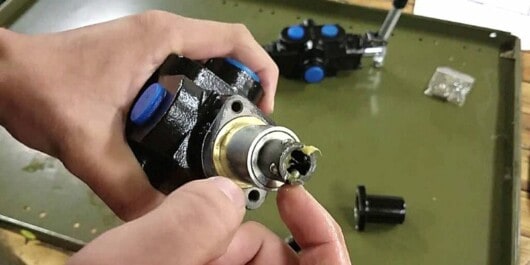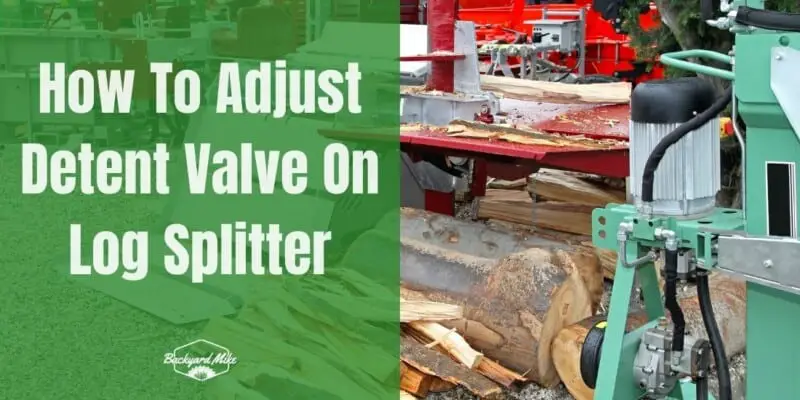Are you a homeowner who regularly uses a log splitter, but you’re struggling to use it because you don’t know how to adjust the detent valve? If so, then you’re in the right place.
Adjusting detent valve on log splitter involves lowering or increasing the spring tension of the log splitter. Over time, the spring tension which controls the detent could become too low or too high. When this occurs, you’ll need to adjust detent valve on log splitter. When the tension is low, the control lever would pop into neutral before the cylinder rod is retracted. Meanwhile, if the tension is high, the control lever will stay in the retracted position and won’t pop into neutral.
In this article, you will get to know all about the detent valve, how to adjust detent valve on log splitter, what does the detent on a hydraulic valve do, how to determine where the problem is before you replace the valve, and more. Continue reading to get all the answers that you are looking for.
What does the detent on a hydraulic valve do?
The detent on a hydraulic valve will control automatic return features. For instance, on a log splitter, it’ll allow for the audio return of the hydraulic piston. This will allow you to get the next log to be ready to split while the piston is returning to the start position. If the detent isn’t working properly, you’ll need to hold the hydraulic control lever in the return position until the cylinder goes back to the start position. It’s very inconvenient and can almost double the time it takes for splitting wood if you’re working alone.
The detent valve in your log splitter is the central assembly where unpressurized hydraulic fluid interacts with the pressurized hydraulic fluid will create unnecessary reactions that get the machine work in the first place. However, in case something goes wrong, and your log splitter lacks pressure or the detent valve isn’t opening, you’ll have to check through the assembly step-by-step for determining where the problem is before you replace the valve. Fixing the auto-return on the hydraulic control valve is usually a matter of tightening the bolt in the detent cover assembly.
Does the detent valve on your log splitter need adjustment?
Over time, the spring tension that controls the detent might become too high or too low. When that happens, a simple adjustment could resolve the issue. Here is what you should look for when the detent valve needs adjusting.
- When the tension is too low, the control lever pops into neutral before the cylinder rod has fully retreated. The only way of retracting the rod fully would be to keep the hand pressure on the lever.
- When the tension is too high, the control lever will stay in the retracted position and won’t pop into neutral on its own.
However, you should remember that not all detent valves come with adjustment relief bolts. You’ll need to check if the valve in your log splitter comes with an adjustable detent. In case the detent fails on your valve, you’ll have to replace the detent mechanism.

How to adjust detent valve on log splitter?
As mentioned previously, a simple adjustment to the relief bolt will be enough to adjust the detent valve. As always, it’s important that you should always use caution and wear proper safety gear. To start off, you’ll need to gather a few tools.
- A 22mm wrench for loosening the locking nut
- A 16mm wrench for loosening or tightening the detent adjustment bolt
Adjust the detent valve if it is set too low
If the control lever of the log splitter pops into neutral on its own before the rod has fully retreated, it’ll mean that the detent adjustment has been set too low. To do so, you’ll need to carry out the following steps –
- Turn off the log splitter’s engine
- Relieve fluid pressure of the system by cycling the control lever a couple of times
- Put the control lever of the machine in the neutral position
- Loosen the locking nut on the log splitter’s return detent adjustment bolt
- Now, turn the bolt clockwise 1/4 turn for tightening the relief spring
- Start the log splitter’s engine and test the detent valve
- Now repeat steps 1st to 6th until the detent valve starts functioning correctly
- Tighten the locking nut
Adjust the detent valve if it is set too high
In case the control lever is in the return position after the cylinder rod has fully retracted, it’ll mean that the detent adjustment has been set too high. To do so, you’ll need to carry out the following steps –
- Turn off the log splitter’s engine
- Relieve fluid pressure by cycling the control lever a couple of times
- Put the log splitter’s control lever in the neutral position
- Loosen up the locking nut on the return detent adjustment bolt
- Now, turn the bolt counterclockwise 4-5 turns
- Start the log splitter’s engine and then test the valve
- If the control lever still remains in the detent return position after the rod has fully retracted, you should repeat steps 1st to 3rd
- Turn the bolt counterclockwise a couple of times more and then repeat step 6th
- Now, repeat steps 7th and 8th if necessary
- If the control lever doesn’t stay in the detent return position on its own, you should repeat steps 1st to 3rd
- Turn the detent adjustment bolt ¼ at a time until the control lever is in the detent while the rod is retracting, but it should also pop into neutral on its own once the rod is fully retracted
- Make sure that you’re turning off the engine, relieve pressure in the system by cycling the control lever a couple of times and put the control lever in the neutral position between every adjustment
- Lastly, tighten the locking nut
How to replace the detent valve?
If the detent valve is broken or isn’t working properly, you’ll need to replace it. Here are the instructions on how to replace the detent valve –
- Once again, you’ll need to remove the detent cover
- After that, unscrew the adjustment bolt all the way to remove the detent assembly from the hydraulic control valve
- Make sure that you wipe away any oil and debris from the detent base before you install the new detent valve (remember not to use a scraper or anything that could gauge the base as it might cause a hydraulic leak)
- Once the detent arrives, it’ll get shipped with the detent assembly already assembled and set in the new detent cover
- The detent cover assembly will be shipped preassembled, you’ll need to remove the detent assembly from the detent cover (Caution – Remember to do this carefully. When sliding the detent assembly out of the detent cover, you shouldn’t allow the assembly to come apart. There will be small bearings inside the detent assembly, held in place by the detent sleeve.)
- You shouldn’t allow the detent sleeve to slide up and improper.
- Carefully, thread the detent into the base threads of the control valve
- After that, tighten it all the way manually while ensuring that you don’t allow the threads to be crossed
- Once it’s in place, snug down the assembly using a large slotted screwdriver
- When you’re installing the new detent assembly, pack the top bearing using grease if it didn’t come greased by the manufacturer
- Now, it’ll be time to screw on the new detent cover and then try it out
- You might have to tighten down the slotted sleeve if it isn’t holding the control lever into the return position
Conclusion
Thank you for reading. Hopefully, now you know a lot more about the detent valve, how to adjust detent valve on log splitter, what does the detent on a hydraulic valve do, how to determine where the problem is before you replace the valve, and more. Adjusting the detent valve on a log splitter involves lowering or increasing the spring tension of the log splitter. Over time, the spring tension which controls the detent could become too low or too high. When this occurs, you’ll need to adjust the detent valve on the log splitter. When the tension is low, the control lever would pop into neutral before the cylinder rod is retracted. Meanwhile, if the tension is high, the control lever will stay in the retracted position and won’t pop into neutral.


